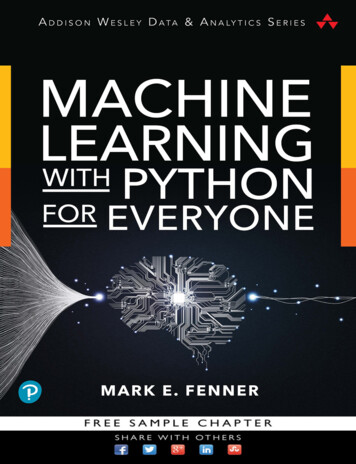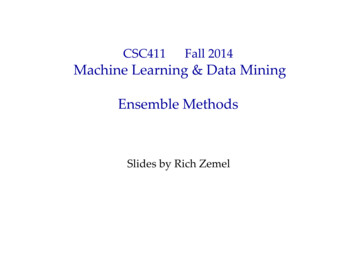
Transcription
Machine Learningwith Pythonfor Everyone
Machine Learningwith Pythonfor EveryoneMark E. FennerBoston Columbus New York San Francisco Amsterdam Cape TownDubai London Madrid Milan Munich Paris Montreal Toronto Delhi Mexico CitySão Paulo Sydney Hong Kong Seoul Singapore Taipei Tokyo
Many of the designations used by manufacturers and sellers to distinguish their products are claimed astrademarks. Where those designations appear in this book, and the publisher was aware of a trademarkclaim, the designations have been printed with initial capital letters or in all capitals.The author and publisher have taken care in the preparation of this book, but make no expressed orimplied warranty of any kind and assume no responsibility for errors or omissions. No liability is assumedfor incidental or consequential damages in connection with or arising out of the use of the information orprograms contained herein.For information about buying this title in bulk quantities, or for special sales opportunities (which mayinclude electronic versions; custom cover designs; and content particular to your business, training goals,marketing focus, or branding interests), please contact our corporate sales departmentat corpsales@pearsoned.com or (800) 382-3419.For government sales inquiries, please contact governmentsales@pearsoned.com.For questions about sales outside the U.S., please contact intlcs@pearson.com.Visit us on the Web: informit.com/awLibrary of Congress Control Number: 2019938761Copyright 2020 Pearson Education, Inc.Cover image: cono0430/ShutterstockPages 58, 87: Screenshot of seaborn 2012–2018 Michael Waskom.Pages 167, 177, 192, 201, 278, 284, 479, 493: Screenshot of seaborn heatmap 2012–2018 MichaelWaskom.Pages 178, 185, 196, 197, 327, 328: Screenshot of seaborn swarmplot 2012–2018 Michael Waskom.Page 222: Screenshot of seaborn stripplot 2012–2018 Michael Waskom.Pages 351, 354: Screenshot of seaborn implot 2012–2018 Michael Waskom.Pages 352, 353, 355: Screenshot of seaborn distplot 2012–2018 Michael Waskom.Pages 460, 461: Screenshot of Manifold 2007–2018, scikit-learn developers.Page 480: Screenshot of cluster 2007–2018, scikit-learn developers.Pages 483, 484, 485: Image of accordion, Vereshchagin Dmitry/Shutterstock.Page 485: Image of fighter jet, 3dgenerator/123RF.Page 525: Screenshot of seaborn jointplot 2012–2018 Michael Waskom.All rights reserved. This publication is protected by copyright, and permission must be obtained from thepublisher prior to any prohibited reproduction, storage in a retrieval system, or transmission in any form orby any means, electronic, mechanical, photocopying, recording, or likewise. For information regardingpermissions, request forms and the appropriate contacts within the Pearson Education Global Rights &Permissions Department, please visit www.pearsoned.com/permissions/.ISBN-13: 978-0-13-484562-3ISBN-10: 0-13-484562-5ScoutAutomatedPrintCode
To my son, Ethan—with the eternal hope of a better tomorrow
This page intentionally left blank
ContentsForewordxxiPreface xxiiiAbout the Author xxviiI First Steps11 Let’s Discuss Learning31.1Welcome31.2Scope, Terminology, Prediction,and Data41.2.1Features51.2.2Target Values andPredictions61.3Putting the Machine in MachineLearning71.4Examples of Learning Systems91.4.1Predicting Categories: Examples ofClassifiers91.4.2Predicting Values: Examples ofRegressors 101.5Evaluating Learning Systems 111.5.1Correctness 111.5.2Resource Consumption 121.6A Process for Building LearningSystems 131.7Assumptions and Reality of Learning 151.8End-of-Chapter Material 171.8.1The Road Ahead 171.8.2Notes 172 Some Technical Background 192.1About Our Setup 192.2The Need for Mathematical Language19
viiiContents2.32.42.52.62.72.82.92.102.11Our Software for Tackling MachineLearning 20Probability 212.4.1Primitive Events 222.4.2Independence 232.4.3Conditional Probability 242.4.4Distributions 25Linear Combinations, Weighted Sums,and Dot Products 282.5.1Weighted Average 302.5.2Sums of Squares 322.5.3Sum of Squared Errors 33A Geometric View: Points inSpace 342.6.1Lines 342.6.2Beyond Lines 39Notation and the Plus-One Trick 43Getting Groovy, Breaking theStraight-Jacket, and Nonlinearity 45NumPy versus “All the Maths” 472.9.1Back to 1D versus 2D 49Floating-Point Issues 52EOC 532.11.1 Summary 532.11.2 Notes 543 Predicting Categories: Getting Startedwith Classification 553.1Classification Tasks 553.2A Simple Classification Dataset 563.3Training and Testing: Don’t Teachto the Test 593.4Evaluation: Grading the Exam 623.5Simple Classifier #1:Nearest Neighbors, Long DistanceRelationships, and Assumptions 633.5.1Defining Similarity 633.5.2The k in k-NN 643.5.3Answer Combination 64
Contents3.5.43.63.73.8k-NN, Parameters, andNonparametric Methods 653.5.5Building a k-NN ClassificationModel 66Simple Classifier #2: Naive Bayes,Probability, and Broken Promises 68Simplistic Evaluation of Classifiers 703.7.1Learning Performance 703.7.2Resource Utilization inClassification 713.7.3Stand-Alone ResourceEvaluation 77EOC 813.8.1Sophomore Warning: Limitationsand Open Issues 813.8.2Summary 823.8.3Notes 823.8.4Exercises 834 Predicting Numerical Values: Getting Startedwith Regression 854.1A Simple Regression Dataset 854.2Nearest-Neighbors Regression and SummaryStatistics 874.2.1Measures of Center: Median andMean 884.2.2Building a k-NN RegressionModel 904.3Linear Regression and Errors 914.3.1No Flat Earth: Why We NeedSlope 924.3.2Tilting the Field 944.3.3Performing LinearRegression 974.4Optimization: Picking the Best Answer 984.4.1Random Guess 984.4.2Random Step 994.4.3Smart Step 994.4.4Calculated Shortcuts 100ix
xContents4.4.54.54.6Application to LinearRegression 101Simple Evaluation and Comparisonof Regressors 1014.5.1Root Mean SquaredError 1014.5.2Learning Performance 1024.5.3Resource Utilization inRegression 102EOC 1044.6.1Limitations and OpenIssues 1044.6.2Summary 1054.6.3Notes 1054.6.4Exercises 105II Evaluation 1075 Evaluating and Comparing Learners 1095.1Evaluation and Why Less Is More 1095.2Terminology for Learning Phases 1105.2.1Back to the Machines 1105.2.2More TechnicallySpeaking . . . 1135.3Major Tom, There’s Something Wrong:Overfitting and Underfitting 1165.3.1Synthetic Data and LinearRegression 1175.3.2Manually Manipulating ModelComplexity 1185.3.3Goldilocks: VisualizingOverfitting, Underfitting, and“Just Right” 1205.3.4Simplicity 1245.3.5Take-Home Notes onOverfitting 1245.4From Errors to Costs 1255.4.1Loss 1255.4.2Cost 126
Contents5.55.65.75.85.95.4.3Score 127(Re)Sampling: Making More from Less 1285.5.1Cross-Validation 1285.5.2Stratification 1325.5.3Repeated Train-Test Splits 1335.5.4A Better Way and Shuffling 1375.5.5Leave-One-OutCross-Validation 140Break-It-Down: Deconstructing Error into Biasand Variance 1425.6.1Variance of the Data 1435.6.2Variance of the Model 1445.6.3Bias of the Model 1445.6.4All Together Now 1455.6.5Examples of Bias-VarianceTradeoffs 145Graphical Evaluation and Comparison 1495.7.1Learning Curves: How Much DataDo We Need? 1505.7.2Complexity Curves 152Comparing Learners withCross-Validation 154EOC 1555.9.1Summary 1555.9.2Notes 1555.9.3Exercises 1576 Evaluating Classifiers 1596.1Baseline Classifiers 1596.2Beyond Accuracy: Metricsfor Classification 1616.2.1Eliminating Confusion from theConfusion Matrix 1636.2.2Ways of Being Wrong 1646.2.3Metrics from the ConfusionMatrix 1656.2.4Coding the Confusion Matrix 1666.2.5Dealing with Multiple Classes:Multiclass Averaging 168xi
xiiContents6.36.46.56.66.76.86.2.6F 1 170ROC Curves 1706.3.1Patterns in the ROC 1736.3.2Binary ROC 1746.3.3AUC: Area-Under-the-(ROC)Curve 1776.3.4Multiclass Learners,One-versus-Rest, andROC 179Another Take on Multiclass:One-versus-One 1816.4.1Multiclass AUC Part Two: TheQuest for a SingleValue 182Precision-Recall Curves 1856.5.1A Note on Precision-RecallTradeoff 1856.5.2Constructing aPrecision-Recall Curve 186Cumulative Response and LiftCurves 187More Sophisticated Evaluationof Classifiers: Take Two 1906.7.1Binary 1906.7.2A Novel MulticlassProblem 195EOC 2016.8.1Summary 2016.8.2Notes 2026.8.3Exercises 2037 Evaluating Regressors 2057.1Baseline Regressors 2057.2Additional Measures forRegression 2077.2.1Creating Our Own EvaluationMetric 2077.2.2Other Built-in RegressionMetrics 2087.2.3R2 209
Contents7.37.47.57.6Residual Plots 2147.3.1Error Plots 2157.3.2Residual Plots 217A First Look at Standardization 221Evaluating Regressors in a MoreSophisticated Way: Take Two 2257.5.1Cross-Validated Results onMultiple Metrics 2267.5.2Summarizing Cross-ValidatedResults 2307.5.3Residuals 230EOC 2327.6.1Summary 2327.6.2Notes 2327.6.3Exercises 234III More Methods and Fundamentals 2358 More Classification Methods 2378.1Revisiting Classification 2378.2Decision Trees 2398.2.1Tree-Building Algorithms 2428.2.2Let’s Go: Decision Tree Time 2458.2.3Bias and Variance in DecisionTrees 2498.3Support Vector Classifiers 2498.3.1Performing SVC 2538.3.2Bias and Variance in SVCs 2568.4Logistic Regression 2598.4.1Betting Odds 2598.4.2Probabilities, Odds, andLog-Odds 2628.4.3Just Do It: Logistic RegressionEdition 2678.4.4A Logistic Regression: A SpaceOddity 268xiii
xivContents8.58.68.78.8Discriminant Analysis 2698.5.1Covariance 2708.5.2The Methods 2828.5.3Performing DA 283Assumptions, Biases, andClassifiers 285Comparison of Classifiers: TakeThree 2878.7.1Digits 287EOC 2908.8.1Summary 2908.8.2Notes 2908.8.3Exercises 2939 More Regression Methods 2959.1Linear Regression in the Penalty Box:Regularization 2959.1.1Performing RegularizedRegression 3009.2Support Vector Regression 3019.2.1Hinge Loss 3019.2.2From Linear Regression toRegularized Regression toSupport VectorRegression 3059.2.3Just Do It — SVR Style 3079.3Piecewise Constant Regression 3089.3.1Implementing a PiecewiseConstant Regressor 3109.3.2General Notes onImplementing Models 3119.4Regression Trees 3139.4.1Performing Regression withTrees 3139.5Comparison of Regressors: TakeThree 3149.6EOC 3189.6.1Summary 3189.6.2Notes 3189.6.3Exercises 319
Contents10 Manual Feature Engineering: ManipulatingData for Fun and Profit 32110.1 Feature Engineering Terminology andMotivation 32110.1.1 Why Engineer Features? 32210.1.2 When Does EngineeringHappen? 32310.1.3 How Does Feature EngineeringOccur? 32410.2 Feature Selection and Data Reduction:Taking out the Trash 32410.3 Feature Scaling 32510.4 Discretization 32910.5 Categorical Coding 33210.5.1 Another Way to Code and theCurious Case of the MissingIntercept 33410.6 Relationships and Interactions 34110.6.1 Manual Feature Construction 34110.6.2 Interactions 34310.6.3 Adding Features withTransformers 34810.7 Target Manipulations 35010.7.1 Manipulating the InputSpace 35110.7.2 Manipulating the Target 35310.8 EOC 35610.8.1 Summary 35610.8.2 Notes 35610.8.3 Exercises 35711 Tuning Hyperparameters and Pipelines 35911.1 Models, Parameters, Hyperparameters 36011.2 Tuning Hyperparameters 36211.2.1 A Note on Computer Science andLearning Terminology 36211.2.2 An Example of CompleteSearch 36211.2.3 Using Randomness to Search for aNeedle in a Haystack 368xv
xviContents11.311.411.511.6Down the Recursive Rabbit Hole:Nested Cross-Validation 37011.3.1 Cross-Validation, Redux 37011.3.2 GridSearch as a Model 37111.3.3 Cross-Validation Nestedwithin Cross-Validation 37211.3.4 Comments on NestedCV 375Pipelines 37711.4.1 A Simple Pipeline 37811.4.2 A More ComplexPipeline 379Pipelines and Tuning Together 380EOC 38211.6.1 Summary 38211.6.2 Notes 38211.6.3 Exercises 383IV Adding Complexity 38512 Combining Learners 38712.1 Ensembles 38712.2 Voting Ensembles 38912.3 Bagging and Random Forests 39012.3.1 Bootstrapping 39012.3.2 From Bootstrapping toBagging 39412.3.3 Through the RandomForest 39612.4 Boosting 39812.4.1 Boosting Details 39912.5 Comparing the Tree-EnsembleMethods 40112.6 EOC 40512.6.1 Summary 40512.6.2 Notes 40512.6.3 Exercises 406
Contents13 Models That Engineer Features for Us 40913.1 Feature Selection 41113.1.1 Single-Step Filtering withMetric-Based FeatureSelection 41213.1.2 Model-Based FeatureSelection 42313.1.3 Integrating Feature Selection witha Learning Pipeline 42613.2 Feature Construction with Kernels 42813.2.1 A Kernel Motivator 42813.2.2 Manual Kernel Methods 43313.2.3 Kernel Methods and KernelOptions 43813.2.4 Kernelized SVCs: SVMs 44213.2.5 Take-Home Notes on SVM and anExample 44313.3 Principal Components Analysis:An Unsupervised Technique 44513.3.1 A Warm Up: Centering 44513.3.2 Finding a Different Best Line 44813.3.3 A First PCA 44913.3.4 Under the Hood of PCA 45213.3.5 A Finale: Comments on GeneralPCA 45713.3.6 Kernel PCA and ManifoldMethods 45813.4 EOC 46213.4.1 Summary 46213.4.2 Notes 46213.4.3 Exercises 46714 Feature Engineering for Domains:Domain-Specific Learning 46914.1 Working with Text 47014.1.1 Encoding Text 47114.1.2 Example of Text Learning 47614.2 Clustering 47914.2.1 k-Means Clustering 479xvii
xviiiContents14.314.4Working with Images 48114.3.1 Bag of Visual Words 48114.3.2 Our Image Data 48214.3.3 An End-to-End System 48314.3.4 Complete Code of BoVWTransformer 491EOC 49314.4.1 Summary 49314.4.2 Notes 49414.4.3 Exercises 49515 Connections, Extensions, and FurtherDirections 49715.1 Optimization 49715.2 Linear Regression from RawMaterials 50015.2.1 A Graphical View of LinearRegression 50415.3 Building Logistic Regression from RawMaterials 50415.3.1 Logistic Regression withZero-One Coding 50615.3.2 Logistic Regression withPlus-One Minus-OneCoding 50815.3.3 A Graphical View of LogisticRegression 50915.4 SVM from Raw Materials 51015.5 Neural Networks 51215.5.1 A NN View of LinearRegression 51215.5.2 A NN View of LogisticRegression 51515.5.3 Beyond Basic NeuralNetworks 51615.6 Probabilistic Graphical Models 51615.6.1 Sampling 51815.6.2 A PGM View of LinearRegression 519
Contents15.6.315.7A PGM View of LogisticRegression 523EOC 52515.7.1 Summary 52515.7.2 Notes 52615.7.3 Exercises 527A mlwpy.py Listing 529Index 537xix
This page intentionally left blank
ForewordWhether it is called statistics, data science, machine learning, or artificial intelligence,learning patterns from data is transforming the world. Nearly every industry imaginablehas been touched (or soon will be) by machine learning. The combined progress of bothhardware and software improvements are driving rapid advancements in the field, though itis upon software that most people focus their attention.While many languages are used for machine learning, including R, C/C , Fortran,and Go, Python has proven remarkably popular. This is in large part thanks to scikit-learn,which makes it easy to not only train a host of different models but to also engineerfeatures, evaluate the model quality, and score new data. The scikit-learn project hasquickly become one of Python’s most important and powerful software libraries.While advanced mathematical concepts underpin machine learning, it is entirelypossible to train complex models without a thorough background in calculus and matrixalgebra. For many people, getting into machine learning through programming, ratherthan math, is a more attainable goal. That is precisely the goal of this book: to use Pythonas a hook into machine learning and then add in some math as needed. Following in thefootsteps of R for Everyone and Pandas for Everyone, Machine Learning with Python for Everyonestrives to be open and accessible to anyone looking to learn about this exciting area ofmath and computation.Mark Fenner has spent years practicing the communication of science and machinelearning concepts to people of varying backgrounds, honing his ability to break downcomplex ideas into simple components. That experience results in a form of storytellingthat explains concepts while minimizing jargon and providing concrete examples. Thebook is easy to read, with many code samples so the reader can follow along on theircomputer.With more people than ever eager to understand and implement machine learning, it isessential to have practical resources to guide them, both quickly and thoughtfully. Markfills that need with this insightful and engaging text. Machine Learning with Python forEveryone lives up to its name, allowing people with all manner of previous training toquickly improve their machine learning knowledge and skills, greatly increasing access tothis important field.Jared Lander,Series Editor
This page intentionally left blank
PrefaceIn 1983, the movie WarGames came out. I was a preteen and I was absolutely engrossed:by the possibility of a nuclear apocalypse, by the almost magical way the lead characterinteracted with computer systems, but mostly by the potential of machines that could learn.I spent years studying the strategic nuclear arsenals of the East and the West — fortunatelywith a naivete of a tweener—but it was almost ten years before I took my first serioussteps in computer programming. Teaching a computer to do a set process was amazing.Learning the intricacies of complex systems and bending them around my curiosity was agreat experience. Still, I had a large step forward to take. A few short years later, I workedwith my first program that was explicitly designed to learn. I was blown away and I knewI found my intellectual home. I want to share the world of computer programs that learnwith you.AudienceWho do I think you are? I’ve written Machine Learning with Python for Everyone for theabsolute beginner to machine learning. Even more so, you may well have very littlecollege-level mathematics in your toolbox and I’m not going to try to change that. Whilemany machine learning books are very heavy on mathematical concepts and equations,I’ve done my best to minimize the amount of mathematical luggage you’ll have to carry. Ido expect, given the book’s title, that you’ll have some basic proficiency in Python. If youcan read Python, you’ll be able to get a lot more out of our discussions. While many bookson machine learning rely on mathematics, I’m relying on stories, pictures, and Pythoncode to communicate with you. There will be the occasional equation. Largely, these canbe skipped if you are so inclined. But, if I’ve done my job well, I’ll have given you enoughcontext around the equation to maybe — just maybe — understand what it is trying to say.Why might you have this book in your hand? The least common denominator is thatall of my readers want to learn about machine learning. Now, you might be coming fromvery different backgrounds: a student in an introductory computing class focused onmachine learning, a mid-career business analyst who all of sudden has been thrust beyondthe limits of spreadsheet analysis, a tech hobbyist looking to expand her interests, or ascientist needing to analyze data in a new way. Machine learning is permeating society.Depending on your background, Machine Learning with Python for Everyone has differentthings to offer you. Even a mathematically sophisticated reader who is looking to do abreak-in to machine learning using Python can get a lot out of this book.So, my goal is to take someone with an interest or need to do some machine learningand teach them the process and the most important concepts of machine learning in aconcrete way using the Python scikit-learn library and some of its friends. You’ll come
xxivPrefaceaway with overall patterns, strategies, pitfalls, and gotchas that will be applicable in everylearning system you ever study, build, or use.ApproachMany books that try to explain mathematical topics, such as machine learning, do so bypresenting equations as if they tell a story to the uninitiated. I think that leaves many ofus—even those of us who like mathematics! — stuck. Personally, I build a far better mentalpicture of the process of machine learning by combining visual and verbal descriptionswith running code. I’m a computer scientist at heart and by training. I love building things.Building things is how I know that I’ve reached a level where I really understand them.You might be familiar with the phrase, “If you really want to know something, teach it tosomeone.” Well, there’s a follow-on. “If you really want to know something, teach acomputer to do it!” That’s my take on how I’m going to teach you machine learning.With minimal mathematics, I want to give you the concepts behind the most importantand frequently used machine learning tools and techniques. Then, I want you toimmediately see how to make a computer do it. One note: we won’t be programmingthese methods from scratch. We’ll be standing on the shoulders of giants and using somevery powerful, time-saving, prebuilt software libraries (more on that shortly).We won’t be covering all of these libraries in great detail — there is simply too muchmaterial to do that. Instead, we are going to be practical. We are going to use the best toolfor the job. I’ll explain enough to orient you in the concept we’re using — and then we’llget to using it. For our mathematically inclined colleagues, I’ll give pointers to morein-depth references they can pursue. I’ll save most of this for end-of-the-chapter notes sothe rest of us can skip it easily.If you are flipping through this introduction, deciding if you want to invest time in thisbook, I want to give you some insight into things that are out-of-scope for us. We aren’tgoing to dive into mathematical proofs or rely on mathematics to explain things. There aremany books out there that follow that path and I’ll give pointers to my favorites at the endsof the chapters. Likewise, I’m going to assume that you are fluent in basic- to intermediatelevel Python programming. However, for more advanced Python topics — and things thatshow up from third-party packages like NumPy or Pandas — I’ll explain enough of what’sgoing on so that you can understand each technique and its context.OverviewIn Part I, we establish a foundation. I’ll give you some verbal and conceptualintroductions to machine learning in Chapter 1. In Chapter 2 we introduce and take aslightly different approach to some mathematical and computational topics that show uprepeatedly in machine learning. Chapters 3 and 4 walk you through your first steps inbuilding, training, and evaluating learning systems that classify examples (classifiers) andquantify examples (regressors).Part II shifts our focus to the most important aspect of applied machine learningsystems: evaluating the success of our system in a realistic way. Chapter 5 talks about general
Prefaceevaluation techniques that will apply to all of our learning systems. Chapters 6 and 7 takethose general techniques and add evaluation capabilities for classifiers and regressors.Part III broadens our toolbox of learning techniques and fills out the components of apractical learning system. Chapters 8 and 9 give us additional classification and regressiontechniques. Chapter 10 describes feature engineering: how we smooth the edges of roughdata into forms that we can use for learning. Chapter 11 shows how to chain multiple stepstogether as a single learner and how to tune a learner’s inner workings for betterperformance.Part IV takes us beyond the basics and discusses more recent techniques that aredriving machine learning forward. We look at learners that are made up of multiple littlelearners in Chapter 12. Chapter 13 discusses learning techniques that incorporateautomated feature engineering. Chapter 14 is a wonderful capstone because it takes thetechniques we describe throughout the book and applies them to two particularlyinteresting types of data: images and text. Chapter 15 both reviews many of the techniqueswe discuss and shows how they relate to more advanced learning architectures — neuralnetworks and graphical models.Our main focus is on the techniques of machine learning. We will investigate a numberof learning algorithms and other processing methods along the way. However,completeness is not our goal. We’ll discuss the most common techniques and only glancebriefly at the two large subareas of machine learning: graphical models and neural, or deep,networks. However, we will see how the techniques we focus on relate to these moreadvanced methods.Another topic we won’t cover is implementing specific learning algorithms. We’ll buildon top of the algorithms that are already available in scikit-learn and friends; we’ll createlarger solutions using them as components. Still, someone has to implement the gears andcogs inside the black-box we funnel data into. If you are really interested in implementationaspects, you are in good company: I love them! Have all your friends buy a copy of thisbook, so I can argue I need to write a follow-up that dives into these lower-level details.AcknowledgmentsI must take a few moments to thank several people that have contributed greatly to thisbook. My editor at Pearson, Debra Williams Cauley, has been instrumental in every phaseof this book’s development. From our initial meetings, to her probing for a topic thatmight meet both our needs, to gently shepherding me through many (many!) early drafts,to constantly giving me just enough of a push to keep going, and finally climbing thesteepest parts of the mountain at its peak . . . through all of these phases, Debra has shownthe highest degrees of professionalism. I can only respond with a heartfelt thank you.My wife, Dr. Barbara Fenner, also deserves more praise and thanks than I can give herin this short space. In addition to the burdens that any partner of an author must bear, shealso served as my primary draft reader and our intrepid illustrator. She did the hard work ofdrafting all of the non-computer-generated diagrams in this book. While this is not ourfirst joint academic project, it has been turned into the longest. Her patience is, by allappearances, never ending. Barbara, I thank you!xxv
xxviPrefaceMy primary technical reader was Marilyn Roth. Marilyn was unfailingly positivetowards even my most egregious errors. Machine Learning with Python for Everyone isimmeasurably better for her input. Thank you.I would also like to thank several members of Pearson’s editorial staff: Alina Kirsanovaand Dmitry Kirsanov, Julie Nahil, and many other behind-the-scenes folks that I didn’thave the pleasure of meeting. This book would not exist without you and yourhardworking professionalism. Thank you.Publisher’s NoteThe text contains unavoidable references to color in figures. To assist readers of the printedition, color PDFs of figures are available for download at http://informit.com/title/9780134845623.For formatting purposes, decimal values in many tables have been manually rounded totwo place values. In several instances, Python code and comments have been slightlymodified—all such modifications should result in valid programs.Online resources for this book are available at https://github.com/mfenner1.Register your copy of Machine Learning with Python for Everyone on the InformIT site forconvenient access to updates and/or corrections as they become available. To start the registration process, go to informit.com/register and log in or create an account. Enter theproduct ISBN (9780134845623) and click Submit. Look on the Registered Products tabfor an Access Bonus Content link next to this product, and follow that link to access anyavailable bonus materials. If you would like to be notified of exclusive offers on new editionsand updates, please check the box to receive email from us.
About the AuthorMark Fenner, PhD, has been teaching computing and mathematics to adultaudiences—from first-year college students to grizzled veterans of industry — since 1999.In that time, he has also done research in machine learning, bioinformatics, and computersecurity. His projects have addressed design, implementation, and performance of machinelearning and numerical algorithms; security analysis of software repositories; learningsystems for user anomaly detection; probabilistic modeling of protein function; and analysisand visualization of ecological and microscopy data. He has a deep love of computing andmathematics, history, and adventure sports. When he is not actively engaged in writing,teaching, or coding, he can be found launching himself, with abandon, through the woodson his mountain bike or sipping a post-ride beer at a swimming hole. Mark holds a nidanrank in judo and is a certified Wilderness First Responder. He and his wife are graduatesof Allegheny College and the University of Pittsburgh. Mark holds a PhD in computerscience. He lives in northeastern Pennsylvania with his family and works through hiscompany, Fenner Training and Consulting, LLC.
This page intentionally left blank
3Predicting Categories: GettingStarted with ClassificationIn [1]:# setupfrom mlwpy import *%matplotlib inline3.1Classification TasksNow that we’ve laid a bit of groundwork, let’s turn our attention to the main attraction:building and evaluating learning systems. We’ll start with classification and we need somedata to play with. If that weren’t enough, we need to establish some evaluation criteria forsuccess. All of these are just ahead.Let me squeeze in a few quick notes on terminology. If there are only two target classesfor output, we can call a learning task binary classification. You can think about {Yes, No},{Red, Black}, or {True, False} targets. Very often, binary problems are describedmathematically using { 1, 1} or {0, 1}. Computer scientists love to encode{False, True} into the numbers {0, 1} as the output values. In reality, { 1, 1} or {0, 1}are both used for mathematical convenience, and it won’t make much of a difference to us.(The two encodings often cause head-scratching if you lose focus reading two differentmathematical presentations. You might see one in a blog post and the other in an articleand you can’t reconcile them. I’ll be sure to point out any differences in this book.) Withmore than two target classes, we have a multiclass problem.Some classifiers t
Contents xi 5.4.3 Score 127 5.5 (Re)Sampling:MakingMorefromLess 128 5.5.1 Cross-Validation 128 5.5.2 Stratification 132 5.5.3 RepeatedTrain-TestSplits 133




